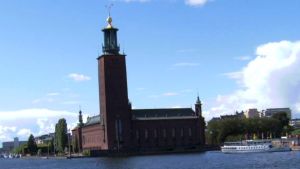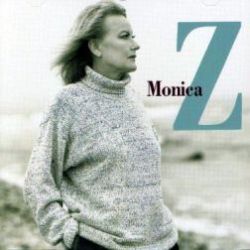
Monica is the name of a Swedish lady who used to walk the streets of Stockholm very late and very slowly, now and again singing in a low but clear voice, “Quietly strolling through the city”, only interrupted by an occasional kiss. Guided by her lyrics alone, I want to copy that walk.
The particular lady is the late Monica Zetterlund, a jazz singer who was also at home in ballads, revues, TV and film dramas. Her characteristic voice, rich and playful with a distinct phrasing, often seemed to detach itself from the music. A childhood accident cost Monica lifelong back problems, which eventually chained her to a wheel chair and made her the easy victim of a tragic fire in 2005, at an age of 68.
My only input, really, is an unmistakable maritime atmosphere, not much help in a city built on 14 islands and backed by an archipelago of 24.000 skerries and islets. The mention of the Western Bridge, Vasterbron, is an important clue that makes me choose the harbor promenade of Norr Malarstrand for my walk. My jumping-off point is the City Hall, Stadshuset; the scene of the annual Nobel Prize Banquet. This means my adventures are concentrated on one single island: Kungsholmen.

Monica walked here around two o’clock in the night, stopping in between to enjoy the kisses of her lover and the strokes of a gentle summer wind. She heard laughing voices far away, while the smell of hay drifted in from the islands. Here in September, it’s different. Apart from a few restaurants staying open, the lake side is rather deserted at night and not the safest place to be. So my own walk is a daytime version, still at a snail’s pace, for I do anticipate some visual impressions at least.
Good Old Boats
New acquaintances await me; members of the Stockholm Ship Association, comprising 110 leisure crafts originally constructed for hard work, not for pleasure, many of them launched over 100 years ago. They have more character than beauty as they lie there side by side, the story of their lives displayed on signs, two on each post; revealing age, changes in ownership, rebuildings for new purposes, or restorations after fires and shipwreck.

Vaino and Skutsje are neighbors, with highly different stories to tell. Built in Russia as a steam tugboat, Vaino was converted to a yacht for the Emperor’s officers, some of whom used it to escape the Russian Revolution via the lakes of Finland, where Vaino was degraded to timber towing. Skutsje looks most inviting with flowers and chairs, as were it still sailing its flat bottom on the Dutch canals. Other vessels came from Germany and Norway to enjoy a renaissance as pleasure crafts in the Archipelago of Stockholm.
Whatever purpose the boats were built for – pulling logs down the Baltic Sea or specialized to be a trawler, pilot boat or mine sweeper – their new owners saw their potential in a growing leisure sector. Investing money, patience and devotion, the result may not always be a beauty queen, but certainly a lady with a past, strong and spectacular, sometimes totally restored. When it comes to renaming, Swedish lake names are popular, so Malaren is of course present, once a fishing boat. Several prefer the boat’s original name, like Fageln from the west coast, The Bird, at one point shipwrecked in a Finnish port.
A faded poster gladly announces The New Archipelago Jazz on board MS Gustafsberg VII from 1912, ten summer nights with Sweden’s Jazzband playing in the sunset, possibly the last performance this year. Such a venue would have suited Monica Zetterlund, provided she kept away from maneuvering the ship, although it could have been extremely funny, recalling her lack of seamanship in “How to Approach a Jetty”, a divine comedy from 1965.

The atmosphere of the harbor is a bit tame, caused by a season drawing to its close. Quite a few of these boats are used for excursions to discover unknown corners of the Archipelago, a typical summer activity. Now is the time for rest and repair, and for lobbying against an imminent threat – a monstrous conference complex larger than the Globen Arena. It’s definitely going to dominate the waterfront of Riddarfjarden, as this easternmost bay of Lake Malar is called. Protest lists are waiting to be signed.
Three Thirds of Stockholm
The Recycle Boat causes no protests, despite the dangerous items continuously being deposited on its deck. A local boat seller, Riddarfjarden Marina AB, is hit by low season; normally a period of planning, but plans for next year are complicated by a possible conference hall. The owners of cafés and kiosks have time for chatting now. Joggers and walkers need not wait in line to explore the latest innovation within public pay-toilets – a dark green metal construction the shape of a loaf. They are few and expensive, so few that Stockholm smells, according to some.
A narrow strip of green, lining the promenade, also acts as a buffer against traffic noise, though without hiding the special attractions along the road: stately residential blocks, 8-9 stories high, exuding wealth and high prices. Those with balconies make a somewhat sad impression, calling out for flowers. “People don’t care!” says a local senior citizen, a tourist in his own town. The reason could be that no flowers can match the beauty of the balcony views.

Again today, the sun and the clouds perform a test of strength. In short glimpses, the water turns from sinister to shining, while Vasterbron seems about to open its two spans toward the sun. The park of Ralambshov takes me to the bridge, in Monica’s words a monument of heavenly peace, at the moment thundering with cars. The height scares me as I admire the marina below. It helps looking up and forward – to see a blue picture vertically framed by Norr and Soder Malarstrand, horizontally by Riddarholmen with the silhouettes of the Old City, Gamla Stan.

At last I understand the three equal thirds of Stockholm: water, green expanses, city structure. “My Stockholm is green,” sang Monica, and the green is everywhere, also on the former prison island of Langholmen, which the bridge traverses before connecting to the island of Sodermalm, the trendier part of Stockholm. I myself, however, descend to Kungsholmen again, where another two parks, Marieberg and Fredshall, take me to Hotel Kristineberg. Its low wings stretch like pink fingers into the greenery, perhaps inspired by the lady adorning the reception area – Greta Garbo!
I suggest they replace Garbo with Monica Zetterlund. The receptionist objects, “Few foreigners know her!” Exactly- they will ask who the lady is, whereupon he should guide them to the bar, soon resounding with her music. Monica might use Swedish words, but she phrases them so carefully and melodiously – in a lazy, seductive manner – that her messages are easily perceived. That would be a promotion Garbo can’t beat.